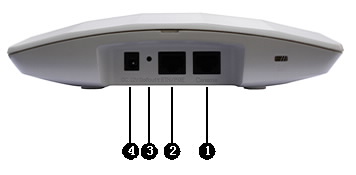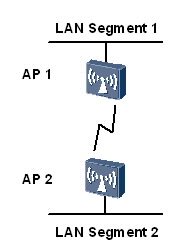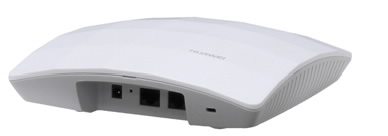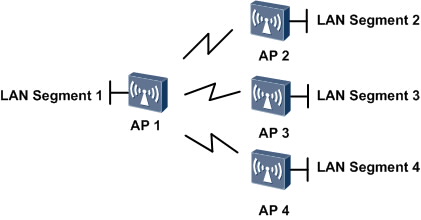AP6010SN Indoor Single-band AP
The AP6010SN is a standard indoor single-band 2x2 MIMO access point (AP) that supports 2.4 GHz frequency band. It complies with IEEE 802.11b/g/n, and works as a Fit AP.

Highly reliable wireless access
- Complies with IEEE 802.11 b/g/n.
- Provides a maximum rate of 150 Mbit/s for each radio.
- Uses Wi-Fi Multimedia (WMM) to implement priority scheduling based on the service type (voice, video, or data), and implements end-to-end QoS through priority mapping on wireless and wired interfaces.
- Supports wired link integrity check.
- Supports load balancing.
- Supports roaming without service interruptions.
- Supports AC hot standby.
- Supports the beamforming technique.
- Uses the latest 802.11n chip to increase the performance by 20%.
- Has a strong coverage capability.
Comprehensive user access control capability
- Supports access control lists (ACLs) and user access controls based on user group policies.
- Provides per-user bandwidth management
- Supports user isolation policies
High security
- Wired Equivalent Privacy (WEP)
- Wi-Fi Protected Access (WPA)/WPA2
- WLAN Authentication and Privacy Infrastructure (WAPI)
- 802.1x
- Detection of unauthorized APs
Flexible networking and environment adaptability
- For use in Fit AP and WDS networking scenarios.
- Automatically selects the transmission rate, channel, and transmit power to adapt to multiple radio environments and limit interference in real time.
- Adjusts bandwidth allocation based on the number of users and radio environment.
Simple device management and maintenance
- Automatically discovers ACs and loads the AC (plug-and-play) configuration.
- Supports batch upgrade.
- Monitored by the NMS in real time. You can remotely configure APs and locate faults on APs using the NMS.
- Supports the Link Layer Discovery Protocol (LLDP) to implement automatic link discovery and obtain the network topology.
WLAN features
- Compliance with IEEE 802.11b/g/n, providing a maximum rate of 150 Mbit/s for each radio
- Priority mapping and packet scheduling based on a Wi-Fi Multimedia (WMM) profile to implement priority-based data processing and forwarding
- Automatic and manual rate adjustment (the rate is adjusted automatically by default)
- WLAN channel management and channel rate adjustment
- Automatic channel scanning (the AP6010SN scans channels used by other APs, measures their interference, and reports the scanning result to the AC to trigger channel adjustment)
- Service set identifier (SSID) hiding
- Signal sustain technology (SST)
- STA power-saving mode
- Control and Provisioning of Wireless Access Points (CAPWAP)
- Automatic AC discovery
Network features
- Compliance with IEEE 802.3u
- Ports: Auto-negotiation of the rate and duplex mode and automatic switching between the Media Dependant Interface (MDI) and Media Dependant Interface Crossover (MDI-X) mode
- 1024 unicast MAC addresses
- VLAN assignment based on SSIDs
- VLAN aggregation on uplink Ethernet ports
- 4093 VLAN IDs (1-4093) and 16 virtual APs (VAPs)
- Uplink ports in tagged and untagged mode
- DHCP client
- PPPoE dialup
- Centralized data forwarding and local data forwarding
- STA isolation in the same VLAN
- ACL
- LLDP
QoS features
- Priority mapping and packet scheduling based on WMM profiles to implement priority-based data processing and forwarding
- WMM parameter management for each radio frequency
- WMM power saving
- Priority mapping for upstream packets and flow-based mapping for downstream packets
- Queue mapping and scheduling
- User-based bandwidth limiting
- Adaptive bandwidth allocation (the system dynamically adjusts bandwidth based on the number of users and radio environment)
Security features
- Open system authentication
- WEP authentication/encryption
- WPA/WPA2 authentication and encryption
- 802.1x authentication and encryption
- WAPI authentication and encryption
- SMS4 decryption for data packets
- Wired link integrity check (the AP stops sending radio signals if the tunnel between the AP and AC is terminated)
Maintenance features
- AP management and maintenance by the AC
- Plug-and-play: automatic AC discovery and automatic configuration loading
- Batch upgrade
- Debugging using Telnet and the serial interface
- Real-time configuration monitoring and fast fault location by using the NMS
- System status alarm
Specifications
Antenna Parameters
Appearance
Ports

1.Console port.
2. ETH/PoE: 10/100/1000M port, which connects to the Ethernet. The port can connect to a PoE switch or a PoE power source to receive power.
3.Default: restores factory settings.
4. Power input port: 12 V DC.
LED Indicators
| Type | Color | Frequency | Description |
|---|---|---|---|
| Default status | Green | Steady on | The AP is just powered on. |
| Running | Green | 0.5 Hz | The system is running properly, the Ethernet connection is correct, and STAs are associated with the AP. |
| 0.2 Hz | The system is running properly, the Ethernet connection is correct, no user is connected, and the system is in low power consumption state. | ||
| Alarm | Green | 4 Hz | The AP is being upgraded. The CAPWAP tunnel is disconnected. The AP is running properly, but does not go online. |
| Error | Red | Steady on | A fault that affects services occurs and cannot be rectified automatically. For example, the system fails to load the DRAM or system software. The fault needs to be rectified manually. |
The AP6010SN is recommended for use in buildings with a simple structure, small area, a high density of users, and require a high capacity, for example, small-scale meeting rooms, bars, and entertainment places. The AP6010SN APs can be flexibly deployed in these places and work in both Fit AP and bridge mode.
Fit AP networking:

In this networking, the AP6010SN functions as a Fit AP that provides only data forwarding functions. The AC is responsible for user access, authentication, AP management, and configurations of security protocols, routing, and QoS.
WDS networking (point-to-point):

WDS networking (point-to-multipoint):
In this networking, the AP6010SN connects two or more independent wired or wireless LANs through wireless links. In a Wireless Distribution System (WDS), the AP6010SN supports point-to-point, point-to-multipoint, and multipoint-to-multipoint networking modes.
Utiles Produits
- AP7130DN-AC Indoor Dual-band AP
- AP7030DN-AC Indoor Dual-band AP
- AP5010DN-AGN Indoor Dual-band AP
- AP5010SN-GN Indoor Single-band AP
- AP7110DN-AGN Indoor Dual-band AP
- AP7110SN-GN Indoor Single-band AP
- AP6610DN Outdoor Dual-band AP
- AP6010DN Indoor Dual-band AP
- AP6310SN Indoor distributed Single-band AP
- AP6510DN Outdoor Dual-band AP




















